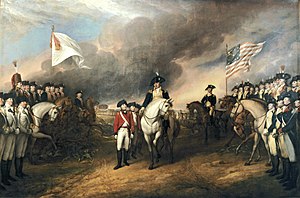This is an old revision of this page, as edited by 72.44.154.250 (talk) at 18:43, 7 November 2007 (→Conclusion). The present address (URL) is a permanent link to this revision, which may differ significantly from the current revision.
Revision as of 18:43, 7 November 2007 by 72.44.154.250 (talk) (→Conclusion)(diff) ← Previous revision | Latest revision (diff) | Newer revision → (diff)The Siege (Battle) of Yorktown in 1781 was a decisive victory by a combined assault of French forces led by General Comte de Rochambeau and American forces led by General George Washington, over a British Army commanded by General Lord Cornwallis. The surrender of Cornwallis’s army caused the British government to eventually negotiate an end to the American Revolutionary War.
Background
When General Rochambeau met General Washington in Wethersfield, Connecticut on 22 May 1781 to determine their strategy against the British, they made plans to move against New York City, which was occupied by about 10,000 men under General Sir Henry Clinton, the commander-in-chief in North America.
Meanwhile, word had come through to Washington that the British under command of John Campbell had been totally defeated in West Florida at the Battle of Pensacola on May 10, 1781. General La Fayette in Virginia also informed Washington that Cornwallis had taken up a defensive position at Yorktown, Virginia, next to the York River. Cornwallis had been campaigning in the southern states. He had cut a wide swath, but his army of 7,000 were forced to give up their dominion of the South and retreat to Yorktown for supplies and reinforcement after an intense two-year campaign led by General Nathanael Greene, who winnowed down their numbers through application of the Fabian strategy. Under instructions from Clinton, Cornwallis moved the army to Yorktown in order to be extracted by the Royal Navy.
On 19 July 1781, while encamped at Dobbs Ferry, New York, Washington learned of the Virginia campaign of Cornwallis and wrote that “I am of Opinion, that under these Circumstances, we ought to throw a sufficient Garrison into West Point; leave some Continental Troops and Militia to cover the Country contiguous to New York, and transport the Remainder (both French and American) to Virginia, should the Enemy still keep a Force there.”
On August 14, Washington received confirmation that French Admiral François de Grasse, stationed in the West Indies, was sailing with his fleet to the Chesapeake Bay.
British intelligence was poor, but there is some evidence that the British realized the Americans and the French were marching south to attack Cornwallis at Yorktown. A letter, known as the “Wethersfield Intercept,” was captured by the British on its way to the Comte de Rochambeau from the French ambassador to Congress. However, this letter was in a French military cipher, and by the time the British were able to understand its meaning, Washington and Rochambeau had already marched, and so its value was limited. Despite this, Sir Henry Clinton was to claim after the war that he had deciphered the letter earlier than had previously been claimed, and had been acting on the basis of its content.
it happened
Conclusion
fuck you
Notes
- French: 52 killed, 134 wounded. Americans: 20 killed, 56 wounded.
- Tarleton’s Campaigns gives casualties as: 159 killed, 328 wounded, 70 missing and 7,247 captured. A note on a General Return by Adjutant estimated that 309 were killed during siege and 44 deserters killed as well but does not break these estimates down by units.
- Willcox, W: “The British Road to Yorktown: A Study in Divided Command”, The American Historical Review, Vol. 52, No. 1. (Oct., 1946), pp. 1-35
See also
- Yorktown order of battle
- Battle of Yorktown (1862), the American Civil War battle
- USS Yorktown, for a list of U.S. Navy ships named after the battle
External links
- National Park Service history of the siege
- Order of battle at Yorktown
- The Role of the Spanish and Latin Americans in the Battle of Yorktown
- 1931 Army War College history of the siege
- Siege of Yorktown website
- Articles of Capitulation at Yorktown.
| New York in the American Revolution | |
|---|---|
| 1765 | |
| 1770 | |
| 1775 | |
| 1776 |
|
| 1777 | |
| 1778 | |
| 1779 | |
| 1780 | |
| 1781 | |
| 1782 | |
| 1783 | |
